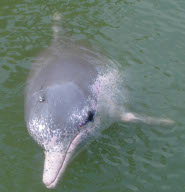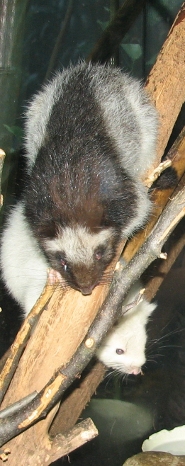Monday 30 May 2011 Indo-Pacific Humpbacked Dolphin - The Lazy Dolphin
 The Indo-Pacific humpbacked dolphin (Sousa chinensis) is a marine mammal that generally inhabits the tropical and temperate reefs and estuaries of the Pacific ocean and the Indian ocean. Their easternmost range extends to between northern Australia and southern China, while their westernmost range extends to the edges of the Indian ocean and southern Africa. They are most common in the coastal waters surrounding Indonesia.
The Indo-Pacific humpbacked dolphin (Sousa chinensis) is a marine mammal that generally inhabits the tropical and temperate reefs and estuaries of the Pacific ocean and the Indian ocean. Their easternmost range extends to between northern Australia and southern China, while their westernmost range extends to the edges of the Indian ocean and southern Africa. They are most common in the coastal waters surrounding Indonesia.Indo-Pacific humpbacked dolphins travel in groups of less than ten individuals, with some groups containing up to 30 individuals. These small, close-knit groups are referred to as pods. They do not have a specific breeding season, and breed all throughout the year. However, they do generally tend to give birth in the summer months between December and February. A generally slow and non-acrobatic marine mammal, males have been known to put on acrobatic displays in order to win mates for breeding.
These dolphins are characterized by their "humped" dorsal fins. Though this hump can be very distinctive in most males, it is not uncommon for males to completely lack this humped dorsal fin. It is also not uncommon for males to have well-defined ridges on their dorsal tail stock. Their bodies are very stocky, making them formidably strong. Indo-Pacific humpbacked dolphins have bee known to drive off and kill sharks, mostly due to this size and strength. Their beaks are highly defined, and look very distinctive. Indo-Pacific humpbacked dolphins are distinctly long and large, topping out at around 10.5 feet (about 3 meters) in large males. Females generally are no larger than 8 (about 2.5 meters) feet long. Adult Indo-Pacific humpbacked dolphins are not known to grow larger than 626 lbs (284 kg).
Being a large fan of reefs, the diet of the Indo-Pacific humpbacked dolphin involves mostly reef fish, crustaceans, and mollusks. Using echolocation, they hunt in smaller groups to pick out their prey from amongst the reef. While they are known to hunt mostly in small groups, it is not unheard of for them to hunt alone. In almost all cases, they are known to eat alone. They are aggressive when feeding, and do not abide intrusion well.
The Indo-Pacific hump backed dolphin is not in any major danger. They are hunted for meat and oil, but not on a significant enough scale to warrant concern. The major impact to their population numbers is found in commercial fishing by-catch. Every year, many dolphins are netted and killed accidentally by commercial fishermen. Their only known predators are sharks.
Picture of the Indo-Pacific Humpbacked Dolphin by takoradee, licensed under GFDL You can help spreading the word about this animal by liking it on facebook

 The
The